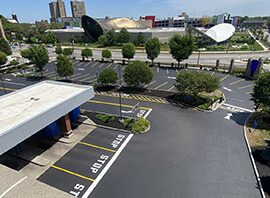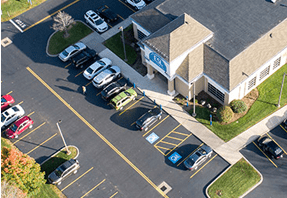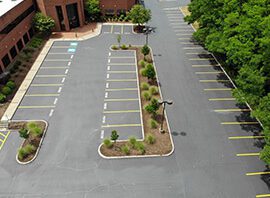Apr 07, 2025 | 1-800-Striper Fairfield County
Ever seen a parking lot where the lines are so faded you can’t tell if you’re parking in a space or the middle of a crosswalk? That’s what happens when line markings lose their battle against the weather.
In Fairfield County—where summers sizzle, winters freeze, and rain sneaks in whenever it pleases— pavement markings must survive for years.
Weather plays a major role in how long line markings last. The same heat that melts asphalt can make paint brittle. Rain and humidity wash away fresh lines before they set. Freezing temperatures stress pavement, causing cracks that break markings apart.
Whether it’s a parking lot, roadway, or sports facility, understanding how Fairfield County’s climate affects markings is key to keeping them visible, durable, and reliable.
It’s not just about aesthetics. Local concerns in the news have been raised about poor lane visibility at night and during rainy conditions, and efforts are underway to improve reflective markings for better driver safety. When line markings fade too soon, they create confusion, slow traffic, and increase the risk of accidents.
That’s why thoughtful planning and the right materials matter.
This guide breaks down how weather impacts line marking in Fairfield County and what you can do to fight back. The right materials, timing, and techniques make all the difference, and with a little planning, your lines can stand strong no matter what the forecast brings.
Fairfield County isn’t exactly known for gentle, predictable weather. Summers crank up the heat, winters get soaked, and storms show up uninvited. If you’ve ever driven through a parking lot with faded, cracked, or smeared lines, you’ve seen the battle between weather and pavement firsthand.
When it comes to line marking in Fairfield County, the elements are more than just a minor inconvenience. They can wreck visibility, shorten a marking’s lifespan, and make a once-crisp layout look like a toddler got loose with a paint roller.
The trick is knowing how to work with the weather instead of against it.
Fairfield County summers can turn asphalt into a frying pan and put every painted line to the test. If the wrong materials are used, markings fade fast, crack early, and lose their visibility just when they’re needed most.
Heat speeds up the drying process, which might sound good, but it weakens the paint’s bond with the pavement. Sunlight doesn’t help either. UV rays wash out colors, making once-bold lines barely noticeable.
Fairfield County’s summers aren’t forgiving, and neither is the pavement. If line markings aren’t designed to handle the heat, they won’t last long.
When the pavement heats up, so does the challenge of keeping line markings sharp and durable. Paint dries too quickly, which means it doesn’t have time to set properly. The bond weakens, making it easier for markings to chip, flake, or wear down under traffic.
Hot asphalt also expands, and it contracts when temperatures drop at night. That constant shift stresses the paint, leading to premature cracks.
High temperatures and direct sun exposure are a tough combination for any marking. UV rays bleach out color, turning crisp white lines dull and making bright yellow paint look washed out.
This isn’t just about appearance. Sun glare already makes it hard for drivers to see pavement markings, and faded lines only make things worse. Heat also causes paint to dry unevenly, leading to distortions that make lines appear wavy or worn before their time.
Not all paints hold up under the Fairfield County sun. Standard traffic paint fades fast and wears out quickly, but UV-resistant thermoplastic paints stand their ground. These materials fuse with the pavement instead of sitting on top, giving them a stronger grip and longer lifespan.
Reflective or high-visibility coatings also help. Sun glare can make markings difficult to see, but reflective paints catch the light in a way that keeps them visible.
Fairfield County winters bring a messy mix of rain, snow, and freezing temperatures. Paint needs time to bond with the pavement, but moisture slows drying, weakens adhesion, and leads to smudging, streaks, and faster fading.
Wet conditions delay drying and ruin fresh markings. High humidity keeps paint from curing properly, while rain can wash lines away before they set. Snow and ice add another layer of trouble. If markings aren’t fully dry before a storm, plows and traffic scrape them off.
Even cured lines take a hit from the freeze-thaw cycle, which cracks paint and speeds up deterioration.
Fairfield County winters don’t just bring snow and rain. Freezing temperatures make line marking a challenge from the moment the paint hits the pavement.
Cold slows down the drying process, weakens adhesion, and increases the risk of cracking or peeling before the markings even get a chance to settle.
Paint behaves differently in the cold. Instead of drying smoothly, it takes longer to cure, leaving it vulnerable to smudging or premature wear. If traffic moves over fresh markings too soon, the paint can lift, streak, or wear away before it properly bonds.
Cold weather also creates application challenges. If temperatures drop too low, paint becomes brittle and struggles to stick to the pavement. Even when it does adhere, freeze-thaw cycles put stress on the markings, causing cracks and peeling long before they should appear.
Winter line marking requires the right products and preparation. Cold-weather paints are designed to bond in low temperatures, drying faster and holding up better against winter’s harsh conditions.
Proper surface preparation is just as important. The pavement needs to be dry and free of ice, salt, or debris to give the paint the best chance to adhere.
A fresh coat of paint means nothing if it doesn’t stick. No matter the season, proper surface preparation is the foundation of long-lasting line markings. Dirt, debris, and moisture all interfere with adhesion, causing paint to flake, fade, or wear away faster than it should. A well-prepped surface ensures that markings stay crisp and durable, even when the weather isn’t cooperative.
Preparation looks different depending on the conditions.
In summer, the pavement needs to be completely clean and dry before application. High heat can cause paint to evaporate too quickly, so it’s important to work early in the morning or late in the evening when temperatures are lower.
In rainy or humid weather, moisture is the enemy. Surfaces should be checked for excess water, and drying time between coats must be extended to prevent smudging and uneven curing.
In cold weather, pavement temperature matters just as much as air temperature. If the surface is too cold, the paint won’t bond properly. Clearing away ice, snow, and salt before applying markings is essential to prevent cracking and peeling.
Skipping surface preparation might save time, but it guarantees problems down the road. A little extra effort upfront means sharper, longer-lasting markings that can stand up to Fairfield County’s unpredictable weather.
Even the best line markings won’t last forever, but regular maintenance can keep them sharp and visible for much longer. Weather takes a toll over time, wearing down paint, fading colors, and causing cracks or peeling.
A proactive approach helps property owners avoid costly repaints and keeps parking lots, roads, and facilities looking professional and organized.
Heavy rain, snow, and heat waves can wear down markings faster than normal conditions. After any major weather event, a quick inspection can reveal fading, chipping, or smudging that needs attention.
Fixing minor wear early prevents the need for a full repaint later.
Regular maintenance is the best thing you can do for your line marking. The best time for fresh line marking is during dry, moderate weather when the paint can cure properly. Summer and early fall tend to be ideal, while winter requires extra precautions to make sure that paint bonds correctly.
Checking for wear in colder and wetter months helps identify markings that need reinforcement before they become unreadable.
A protective sealant adds an extra layer of defense against UV rays, moisture, and heavy traffic. These coatings help prevent fading, cracking, and early wear, reducing the need for frequent repaints.
In areas with unpredictable weather shifts, they’re a smart investment for long-term durability.
Fairfield County’s climate isn’t easy on pavement markings. Between scorching summers, rainy seasons, and freezing winters, line markings face constant wear and tear.
The key to durability isn’t just using high-quality paint—it’s working with a service that understands how local weather affects every stage of the process.
At 1-800-STRIPER, we engineer our line painting to withstand Fairfield County’s unpredictable weather.
Our team understands how heat, moisture, and cold impact line markings, and we use weather-appropriate materials and techniques to keep them visible and durable. We choose UV-resistant paints for summer, fast-curing formulas for humid conditions, and cold-weather coatings for winter applications.
Don’t let Fairfield County’s weather ruin your markings. Schedule a consultation and get durable, high-visibility lines built to last.

Had our parking lot paved and found ourselves needing lines. Their team was fantastic from start to finish. They took the time to give great advice and listened closely to our company’s needs.

They are very responsive and complete the work in a timely fashion. I have used them for 18 years and have never had any issue with their work. Very highly recommended.

They are very easy to work with and have a highest level of attention to detail. They are very knowledgeable and passionate about parking lot striping. Their quality of work is outstanding!
COPYRIGHT © 1999-2025 | ALL RIGHTS RESERVED STRIPER INDUSTRIES, INC. | Privacy Policy